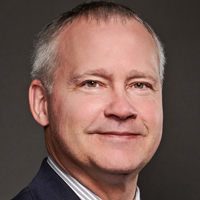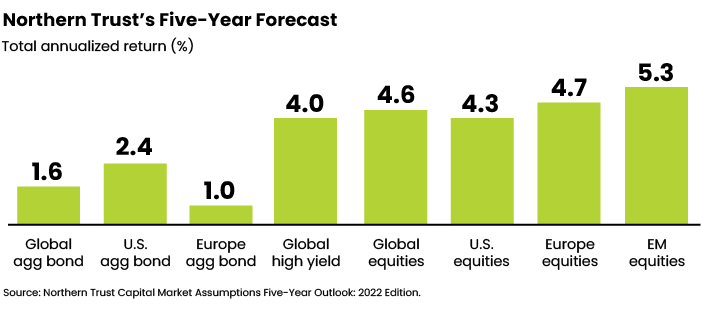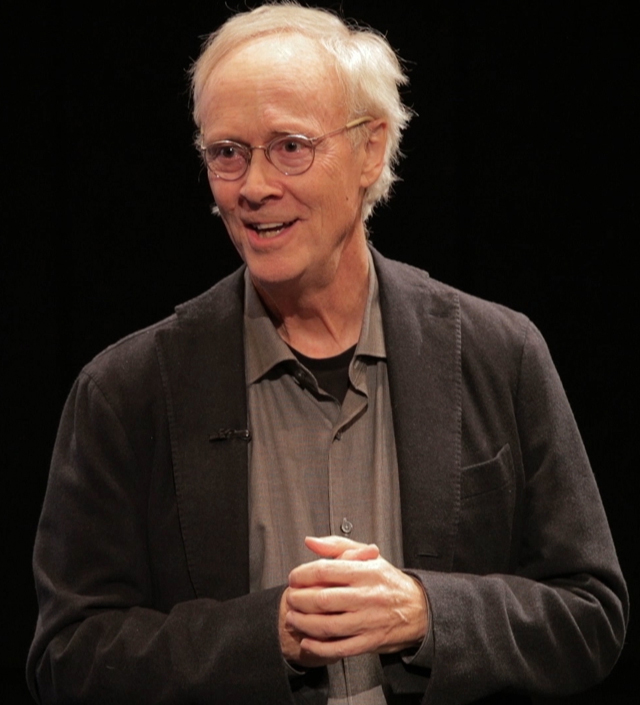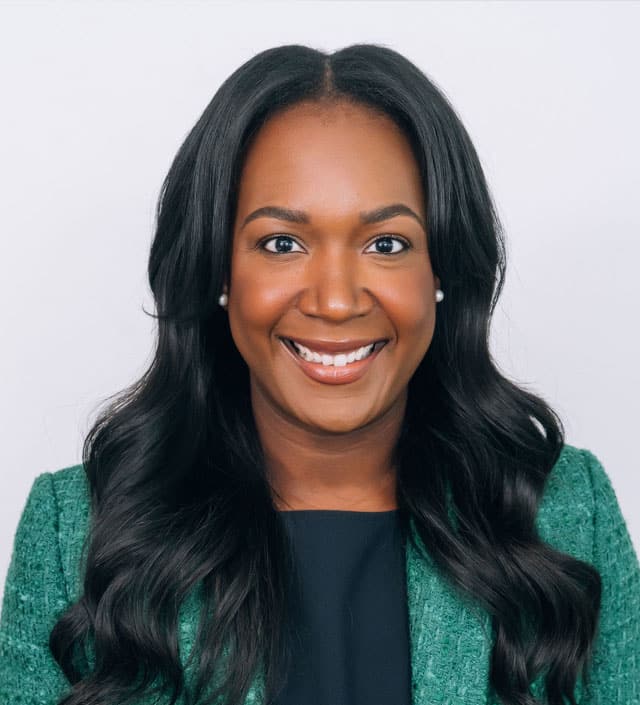Editor’s Note: Many advisory clients nearing or in retirement have been on edge wondering where to find income as interest rates remain very low and inflation rears its ugly head at the gas pump, grocery store, car dealership and elsewhere. To get some perspective and ideas, Rethinking65 reached out to Colin Robertson, managing director of fixed income for Northern Trust Asset Management. (NTAM’s AUM was $1.2 trillion as of Sept. 30, 2021.)
Jerilyn Klein: Colin, I’d like to learn how financial advisors can help older clients find income, and perhaps some peace of mind, amid the macroeconomic backdrop. The 2022 edition of Northern Trust’s Capital Market Assumptions Report [the five-year forecast across Northern Trust Corp.] includes a number of themes. Can you briefly share the most important takeaways here for financial advisors?
Colin Robertson: In my opinion, the most important pieces are clearly the themes about “stuckflation” — inflation being stuck at low levels — and “the reversion to mediocrity,” which in a sense says we get back to mediocre growth. Obviously, the world has changed a lot in the last year-and-a half-plus. But we continue to stand by our longstanding pre-pandemic expectations that rates will stay lower than most investors think and that growth will stay low.
[Over the next five years, Northern Trust expects annualized real GDP growth of 2.1% for the U.S. and 2.9% for the global economy. It forecasts the U.S. to experience annualized inflation of 2.0% over the next five years, compared with market expectations of 2.5%. And it expects developed markets, on a weighted-average basis, to have lower annualized inflation than what most central banks target (1.7%, compared with 2%).]
It’s not as if we don’t look for changes and expect changes sometimes. But the thought process that we come through a pandemic and then suddenly we have significant inflationary pressures that are sustainable, is hard for me to get to and hard for us to get to. Inflation has been low for the previous 20 years.
Klein: What’s behind your expectations for mediocre growth and lower inflation, and where do you see interest rates headed over the next six months to a year?
Robertson: The happenings that were previously in the market and economies are still in place — secular stagnation, aging populations and also, with respect to fixed income, the supply-demand dynamic. There’s a lot of demand for not only fixed-income assets but also other assets offering yield. Continued automation, or a reduction in the human physical footprint in production, will also be deflationary. And I’d be remiss if I didn’t tie in our expectation that central banks will continue to be accommodative.

That doesn’t necessarily mean there won’t be slightly higher interest rates, and there certainly could be in other countries, but the real theme there is that the accommodation continues. Our six-month forecast for 10-year U.S. Treasury yields is in the 125 to 175 basis-point range — right where we are today. I think 10-year Treasurys will continue to have a one handle on them, at best. But if they get to 2% and that’s where they sit, that’s still really low. I think they’ll be lower, but the real message is, don’t expect them to be dramatically higher or much higher.
Beyond six months, rates could actually be lower than they are today. That’s far off the consensus. I wouldn’t move my range up; if anything, I would likely move it lower. I briefly mentioned — but I think it’s important for you and those that you’re helping —that there’s a real lack of supply of fixed-income securities in general. The Treasury is actually cutting back issuance in 2022, which is just going to make it that much more difficult to find yield in the fixed-income space.
Klein: Rising energy prices are a big part of the sharper inflation we’ve recently been seeing. Could the threat of even higher energy costs, given the push for less dependence on fossil fuels and the cost of transitioning to renewables, further play into inflation?
Robertson: It’s a really good question, but it’s not a major focus now. I think that’s a longer-term phenomenon — the second half of the decade at the earliest. Electric vehicles are a piece of it, and it will take a lot longer for us to move down that glidepath then some people think.
Klein: Let’s talk about investing. What areas of fixed income are you currently overweighting — in terms of areas of the yield curve and asset classes?
Robertson: In both a fixed-income sense and in a general investment sense, the idea would be to overweight risk. High yield is a very attractive asset class to us, and we would be overweight that in both a fixed-income portfolio and a full asset allocation portfolio. We’re underweight inflation-protected funds (TIPs) and cash. I think ultra-short fixed income is very attractive and a good alternative to cash; you can take more duration risk and more credit risk. A Treasury money market fund doesn’t even have any credit risk. We don’t have a negative view on investment grade credit; it’s just that there are other asset classes that one can invest in that have a better return profile.
Whatever your investment profile and risk profile are, the answer is to be maxed out on both duration [interest-rate sensitivity] and credit. That means different things to different people, depending on what they’re comfortable with, so it’s hard to give a particular number for duration.
The vast expectations of investors in the market, which I don’t think is going to change, is that interest rates are going to go higher. So, if that’s the expectation, it’s difficult to see that curve not getting some steepness to it. The only exception would be if investors are right and interest rates start to go higher, more quickly, then you’ll likely get a flattening. But keep in mind that’s not our forecast and that’s not my forecast. So as long as my forecast is what I shared with you earlier, you almost have a “Waiting for Godot,” waiting for Fed hikes.
Klein: Why do you think high yield is attractive and how do you suggest advisors and investors approach it?
Robertson: What you’re getting with high yield is clearly the best deal in fixed income. I would always recommend a very diversified high-yield fund or high-yield ETFs — I’m not going to name names. That’s a much safer way to go about it than singular bonds.
High yield ties back to stagflation and low growth, etc. And as an asset class right now, according to rating agencies, it’s less risky than it was, let’s say a decade ago. So it’s harder to call it junk, because it’s actually higher quality. The default levels are low, and likely to stay low. And the supply and demand dynamics that I told you about have investors reaching for yield; you can’t go everywhere, but you can go here and get some.

I also think high yield is a very attractive long-term asset class, and one that an investor should rarely be underweight. When people compare current adjusted spreads to where high yield has been historically, they’re sort of apples and oranges, because it’s not the same type of level of risk in the markets. Versus previous markets, you could actually have tighter levels in high yield today than back then.
We’ve also seen the central banks support the markets under times of extreme stress for many years. When the Fed came in and supported the credit markets at the start of the pandemic, they just flat out, by word and some action, put an absolute floor on how bad things could get. That is hugely important, but what I think is more important — which was sort of glossed over recently — is that when the Fed got out of the market, there was no disruption in the market whatsoever. I think that in a time of extreme stress — I’m not talking about a mild recession — the central banks are going to use the exact same playbook that they just used. Whether it’s right or not is a different conversation, but they’re going to come in and support and effectively save the market. I know it’s a long answer but I think it’s very important for people to understand with respect to this asset class.
Klein: Getting back to ultra-short: What duration does it typically have and are all different kinds of fixed-income securities thrown in there?
Robertson: You’re really maxing out at one-and-a-half years; the central tendency would be a year. Ultra-short pretty much looks at the whole universe of fixed-income securities in that short part of the market. It can be virtually anything — short-term munis, commercial paper, short-term investment grade securities. You can have some entities that will have a small allocation to short-term high-yield securities; that’s pretty rare though. You can have Treasurys and stuff like that, but it probably isn’t going to give bang for the buck, so in general there’s not much. With ultra-short, you probably get paid more for the duration risk you’re taking; it’s not a guarantee, but it’s very stable. It would only be unstable in a time of tremendous stress — but in my opinion, as I mentioned, until something changes the Fed is going to come in. I think ultra-short is dramatically undervalued right now.
Klein: Can you share your tactical asset allocations?
Robertson: Sure. In an overall asset allocation portfolio, we would have roughly 0% cash, 30% in investment grade, 10% in high yield, 30% in U.S. equities, 15% in developed ex-U.S. equities, and the balance in emerging market equities and real assets — global real estate and global natural resources. If you think about a standard 60/40 portfolio that one might have right now or maybe that’s their benchmark, we’d be 71% risk assets/29% risk control — so an extra 11% in risk and 11% less in risk control. Risk control includes cash and inflation-linked debt (which we don’t have now) and investment-grade debt.
In a straight fixed-income portfolio — we don’t really have a model like that — it would depend very strongly on the risk profile of the fixed-income investor. If fixed income was all I had, without a doubt I’d have 20% to 25% in high yield, and another 30% in ultra-short or something like that. The other 50%, you mess around how you would want to with tax-exempt, high-yield and investment-grade debt; with Treasurys if you want some; and nothing cash —unless someone says, “I have to all the time have 5% in cash. I get it, I just personally wouldn’t want to. If I really have a liquidity crunch, I’d just use my ultra-short allocation to get the liquidity I need.
Would I favor high yield over investment grade in a straight fixed-income portfolio? I would, and for a couple of reasons. One, it yields a lot better, and two, its duration is lower. So, if I’m slightly wrong on the interest rate side of the equation, it’s just another reason for high yield to look better than investment grade. But again, I don’t want it to come off as if I’m throwing investment grade under the bus. It’s just that in an overall asset allocation, there are better choices.
Klein: Many people in their 50s and 60s remember their parents or grandparents collected very high interest rates on their investments in the 1980s, with little or no risk. What should advisors say to clients who are worried about finding enough income in retirement?
Robertson: I remember it too — my student loan was over 9%, and that was a discounted rate. There’s no magic sauce, and it’s a tough conversation to have. If they want to have the type of return and retirement that they saw their grandparents have, the only way to get there is to take more risk. So there just has to be an acceptance of either, “I’m going to take the risk I want to take, and I’m going to suffer with lower returns,” or “I’m going to take more risks than maybe I would have wanted to but that’s my only way to achieve my goals.” I’ve given a lot of people that answer and they don’t like it, but unfortunately I think it’s what it is.
Klein: How else can financial advisors help clients who are close to or in their retirement years find more income? Can you offer any guidance for advisors whose clients may have left the workforce sooner than expected because of the pandemic?
Robertson: My advice would be just in a simple sense, save where you can save. Do that analysis of how much income you genuinely think you’re going to need. And then, as I mentioned before, determine what your risk tolerance is. In the past, when one was in those retirement years and left the workforce, the advice would have been, don’t invest in anything risky or too volatile. I disagree with that thought process now. Even for someone who is well into their less risky mode of investing, high yield is an asset class that they should look long and hard at, and quite frankly, just put it under the under the hood and that’s it. Don’t do anything with it. If there is some volatility in any given year, it doesn’t matter — just hold it, because it will come back again. If you went to cash, you’re not earning anything.
The biggest mistake I’ve seen investors make over the last decade, both institutional and individual, is getting out of the high-yield market. What we see as portfolio managers today, Jeri, — this is an important point that hopefully can help — is that years and years ago when there was a liquidity crunch in high yield, high-yield portfolio managers were worried that they wouldn’t be able to generate liquidity for their outflows. That has totally flipped on its head. Now they worry, “I will never be able to buy that bond again, someone else will take it,” because it’s probably their highest quality high-yield bonds. That’s a real sea change from where the high-yield market was a decade or a decade-and-a-half ago.
My other advice to advisors is it’s a really difficult asset class to time. More often than not, people get it wrong — about 80% of the time. With individual investors, they get into this situation where they’re chasing their tail. It’s up again and up again, and they don’t do anything.
Klein: Within high yield, are there any particular industries you’re looking at?
Robertson: I’m just a huge advocate for the very diversified high-yield mutual funds or ETFs.
Klein: Have you always had that big interest in diversified mutual fund and ETFs, rather than individual bonds? And if that’s changed, why?
Robertson: A decade ago, I probably would’ve given you a different answer and we would have acted in a different way. Your question is spot on, and certainly more diversification versus less is the way to go. That puts you in a position where you just don’t have to have to worry about it. Unless your goal is to get out of that asset class for the rest of your life, there’s no reason to leave it.
Klein: Any suggestions on how retirees can take required minimum distributions while still maximizing their income opportunities? Should they look to withdraw some of their fixed income before other fixed income? I guess if they’re in funds, it’s probably not as big of a deal as if they’re holding individual securities.
Robertson: Yeah, if you’re in funds it’s not as big of a deal. If you’re holding individual securities, my best advice would be that, as long as you don’t have again a situation where you’ve got a liquidity crunch in your own personal life/portfolio, you just systematically do it. I wouldn’t necessarily pick one versus another, other than reiterating my stance that quite frankly high yield would probably be the last class I’d get out of.
Klein: Colin, thanks for speaking with me today and one last question: If the pandemic drags on say through 2022, would this impact your outlook or Northern Trust’s market forecast?
Robertson: We don’t think it’s going to last that long. But if it did, it would just push out the current views we have into a longer timeframe. So it would make our five-year view a six-year view.
Jerilyn Klein is editorial director of Rethinking65







